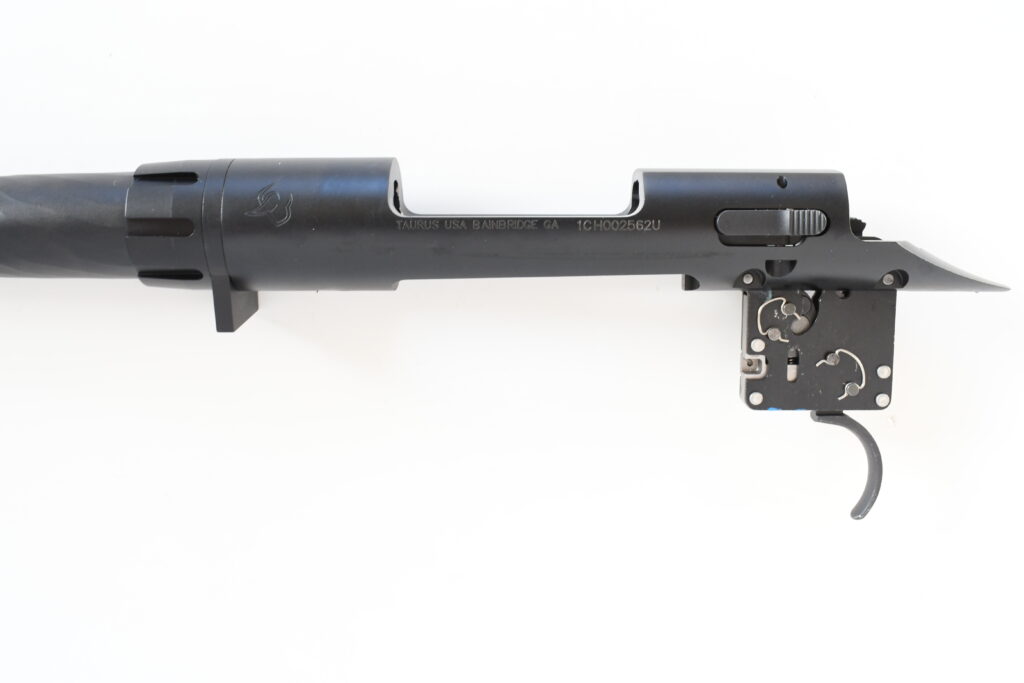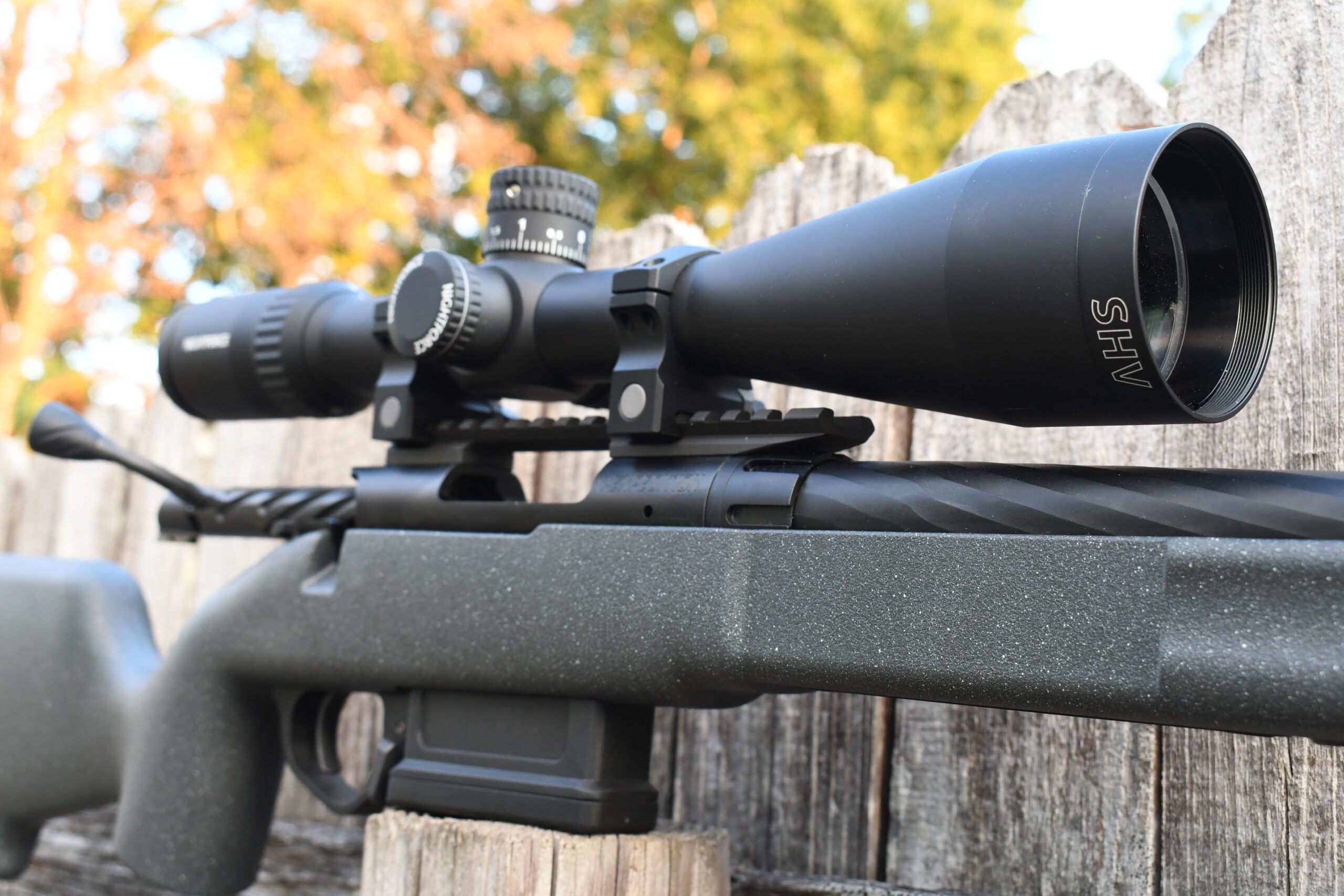Taurus launching a bolt-action hunting rifle in 2024 was something I did not expect to see, let alone shoot and review.
Sure.
Advertisement — Continue Reading Below
I’ve had the privilege to both shoot and write some of these models, with my most recent work covering the Taurus 692 Executive Grade revolver. That Taurus launches different revolver and pistol models every calendar year is no surprise to anyone. They are, after all, primarily focused on handguns and revolvers in our North American market.

But a bolt-action hunting rifle? That certainly wasn’t what I was expecting to see on opening day of SHOT Show 2024—the Tuesday morning after everyone’s favorite crowd pleaser, SHOT Media Range Day, when I strolled over to the Taurus booth to pester Caleb.
Advertisement — Continue Reading Below
But there it was, the Taurus Expedition Rifle. The first things that caught my eye were its distinctive granite-gray stock and its spiraled barrel.
Taurus Bolt Action Expedition Rifle Overview

The Taurus Expedition Rifle certainly predicates itself on modern universal bolt-action rifle design language, such as the use of AICS pattern detachable magazines or a Remington 700-derived action. However, this new rifle from Taurus is also not merely a generic product that simply checks off boxes, either.
Advertisement — Continue Reading Below
The Expedition Rifle is also not the most expensive rifle on the rack, but it’s certainly not the cheapest either. All in all, it shows a considerable amount of effort on behalf of the Taurus team and their goal of fielding a practical hunting rifle with much to offer for value for its street-price of $800 (give-or-take).
Expedition rifles were originally launched with 18-inch barrels and a .308 Winchester chambering, and that’s what my rifle consists of. Alternatively, Taurus does offer a 20-inch version chambered for everyone’s favorite middlebore cartridge, the 6.5mm Creedmoor.
Receiver And Action
Much the same way that the tilting Browning delayed blowback mechanism is the lingua franca of modern semi-automatic handguns, the Remington 700 action is the same for the majority of bolt-action rifles built these days. It provides shooters with a straightforward push-feed action and a convenient thumb-accessible safety lever above the rifle’s wrist, behind the receiver.
Advertisement — Continue Reading Below
This cosmopolitan configuration also places a handy latch on the left side to release the bolt from the receiver’s raceway. The top of the Expedition’s receiver is pre-drilled and tapped for 6/48 screws and accepts any short-action Remington-700 bases, which makes finding rings and installing scope bases on the Expedition easy.


Advertisement — Continue Reading Below

The Expedition’s bolt is fluted and uses a tri-lug design. It also employs a pair of dual ejectors—something I’ve come to appreciate when cycling empty brass. Because the ejectors work in tandem, it doesn’t matter how swiftly or softly the shooter cycles the bolt. Spent casings will pop out with vigor regardless.
The bolt’s knob and stem are low-profile so as to not interfere with the shooter or their gear in the field. The bolt’s shroud also has a “rifle-cocked” indicator that protrudes when the action is ready to fire.
Advertisement — Continue Reading Below
Trigger
The Taurus Expedition Rifle is outfitted with an adjustable single-stage trigger. From the factory, my rifle’s trigger breaks at an average of 2-lbs, 12-ounces—according to my electronic trigger-pull scale. Prior to breaking, the slack before the wall is virtually imperceptible, and it won’t be noticed in the field or on the range. The trigger is satisfactory as it arrived out of the box, and I didn’t feel the need to mess with it.

The Expedition’s Stock
The Expedition’s weatherproof synthetic stock, molded fully in-house by Taurus, is perhaps the most interesting feature about the entire rifle (despite the fact that I’m quite fond of its cold hammer-forged barrel). With the aim of keeping costs down, the Expedition’s stock is not some fancy monocoque affair with a rigid exoskeleton. But it also isn’t a generic molding either.
Advertisement — Continue Reading Below
Even though this stock won’t win any beauty pageants, it is definitely feature-rich from butt to fore-end. Internally, it is aluminum pillar bedded and free-floats the action. To secure the barreled action onto the stock, the Expedition rifle uses T-27 Torx action screws. On my rifle, I can slip an index card all the way to the juncture between the barrel and receiver. Externally, the Expedition’s granite-colored stock has very mild pebbling strewn about.
Beginning from rear to front, Expedition stocks include a generous soft rubber recoil pad whose dampening effects are welcomed. The butt itself doesn’t have the “traditional triangular shape” with that long length of pull, long curving wrist, and long comb. Instead, the butt takes on the contemporary profile seen on more “precision-oriented” rifles. So, the Expedition’s butt is shorter, and its wrist is more vertical with a wider palm swell.
This “newer” lends itself better when taking shots from a slew of different positions, something that is handy in the field, no doubt. To facilitate shooting with a riflescope, the Expedition’s stock incorporates an elevated comb that lends itself to pairing up perfectly with most medium-height scope rings. Finally, the bottom portion of the butt ahead of the toe is squared-off to better ride a rear-bag while shooting; a single sling-swivel stud can also be found here.
Advertisement — Continue Reading Below



The Expedition Fore-End
The Expedition’s fore-end can be likened to a Swiss Army knife because it serves hunters in many different ways. The portion ahead of the receiver is pared down in order to fit with gripping-style tripods or gun saddles. Furthermore, the bottom part of the fore-end includes two M-LOK slots, a QD slot for Spartan Precision bipods, and the traditional front sling-swivel stud.
In short, the Expedition’s stock is designed to facilitate all popular hunting styles, from blinds and stands to using the natural scenery while taking the shot.
To Be Continued In Part 2















